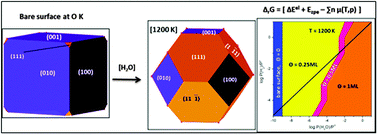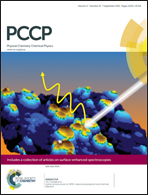Stability, equilibrium morphology and hydration of ZrC(111) and (110) surfaces with H2O: a combined periodic DFT and atomistic thermodynamic study
Abstract
ZrC is a non-oxide ultra-high temperature ceramic (UHTC) material with excellent physical and mechanical properties used in nuclear plants and jet propulsion engines. However, the mechanical properties can be lost because of the easy oxidation of its grain surfaces. One way of dealing with such a problem is to coat the surface with inert carbides like SiC which can be grafted onto the ZrC surface by first modifying the exposed surfaces with reactive molecules. The stability of different terminations of the (111) facet was studied and the most stable is the termination on both surface layers by Zr atoms as it has been observed experimentally. A DFT calculation study jointly with atomistic thermodynamic modelling has been used to study the reactivity of the (111) and (110) facets with H2O. H2O dissociates into surface hydroxyl groups with the release of H2 and the OH groups preferentially adsorb at high surface coverage (high adsorption energies at 1 ML coverage). The study of adsorption of H2O onto other low index surfaces allows the determination of the equilibrium morphology of the ZrC nanocrystallites in different environments. In vacuum, ZrC nanocrystallites reveal a cubic structure with much of the (100) surface and a small amount of the (111) facets at the corners. Hydration of the (111) surface was a strong process and hence water can be removed from the surface at temperatures above 1200 K and pressures lower than 10−9 bar while higher pressures of H2 in the gas phase enhance the removal of water. The Wulff construction of the nanocrystallites after hydration indicates only the (111) surface at lower temperatures while revealing the (100) facets at higher temperatures. Thus whatever the experimental conditions be, the (110) facet does not have to be considered.


 Please wait while we load your content...
Please wait while we load your content...